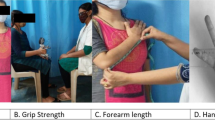Abstract
Hand grip strength is an inevitable component in the evaluation of rheumatoid arthritis, neuromuscular, preoperative, post operative patients and community dwelling older adults' functional capacity. Hand grip varies greatly with age, gender and the anthropometric measures when measured by hand dynamometer. The influence of above variables on hand grip when measured by modified sphygmomanometer is unknown. Further, the prediction of hand grip from age and anthropometric traits is unknown. 229 subjects (115 males and 114 females) with age 23 ± 2 and 21 ± 2 respectively were included in the study after informed c nsent. Weight and height were obtained using standard techniques. Hand grip was measured using a modified sphygmomanometer. Information regarding physical activity and health status was obtained by interview, clinical screening and stratified. Stepwise multiple regression analysis was sought out for any influence of age, height, weight and Body Mass Index (BMI) on hand grip strength. Grip strength correlated moderate to high with age (r = 0.44, p = 0.00), height (r = 0.57, p = 0.00), weight (r = 0.57, p = 0.00) and BMI (r = 0.29, p = 0.00). The regression model for handgrip strength is Hand grip = −1790.54 + 4.93557 × Age–11.7429 × Weight + 1083.4 × Height + 34.194 × BMI. Age, height and weight are the i portant determinants of the handgrip evaluation. In clinical setting, the influence of age and anthropo etric traits on handgrip shall be borne in mind when measuring handgrip by modified sphygmomanometer in age group of 20–25 year patients.


Similar content being viewed by others
References
MacDermid JC, Kramer JF, Woodbury MG et al (1994) Interrater reliability of pinch and grip strength measurements in patients with cumulative trauma disorders. Journal of Hand Therapy 7:10–14
Sande LP, Jane H, Coury CG et al (2001) Effect of musculoskeletal disorders on prehension strength. Applied Ergonomics 32:609–616
Boissy P, Bourbonnais D, Carlotti MM et al (1999) Maximal grip force in chronic stroke subjects and its relationship to global upper extremity function. Clinical Rehabilitation 13:354–362
Griffith CD, Whyman M, Bassey EJ et al (1989) Delayed recovery of hand grip strength predicts postoperative morbidity following major vascular surgery. The British Journal of Surgery 76:704–705
Hunt DR, Rowlands BJ, Johnston D (1985) Hand grip strength—a simple prognostic indicator in surgical patients. JPEN Journal of Parenteral and Enteral Nutrition 9:701–704
Rantanen T, Guralnik JM, Foley D et al (1999) Midlife hand grip strength as a predictor of old age disability. JAMA 281:558–560
Petrofsky JS, Lind AR (1975) Aging, isometric strength and endurance, and cardiovascular responses to static effort. Journal of Applied Physiology 38:91–95
Wang Angela Yee-Moon, Sea Mandy Man-Mei, Ho Zoe So-Ying et al (2005) Evaluation of handgrip strength as a nutritional marker and prognostic indicator in peritoneal dialysis patients. American Journal of Clinical Nutrition 81:79–86
Sartorio A, Lafortuna CL, Pogliaghi S, Trecate L (2002) The impact of gender, body dimension and body composition on hand-grip strength in healthy children. Journal of Endocrinological Investigation 25:431–435
Visnapuu M, Jurimae T (2007) Handgrip Strength and Hand Dimensions in Young Handball and Basketball Players. Journal of Strength and Conditioning Research 21:923–929
Budziareck MB, Pureza Duarte RR, Barbosa-Silva MC (2008) Reference values and determinants for handgrip strength in healthy subjects. Clinical Nutrition 27:357–362
Jürimäe T, Hurbo T, Jürimäe J (2009) Relationship of handgrip strength with anthropometric and body composition variables in prepubertal children. Homo 60:225–238
Kaegi C, Thibault MC, Giroux F, Bourbonnais D (1998) The interrater reliability of force measurements using a modified sphygmomanometer in elderly subjects. Physical Therapy 78:1095–1103
Spijkerman DC, Snijders CJ, Stijnen T, Lankhorst GJ (1991) Standardization of grip strength measurements. Effects on repeatability and peak force. Scandinavian Journal of Rehabilitation Medicine 23:203–206
Peolsson A, Hedlund R, Oberg B (2001) Intra- And Inter-Tester Reliability and Reference Values for Hand Strength. Journal of Rehabilitation Medicine 33:36–41
Sartorio A, Lafortuna CL, Pogliaghi S, Trecate L (2002) The impact of gender, body dimension and body composition on hand-grip strength in healthy children. Journal of Endocrinological Investigation 25:431–435
Chatterjee S, Chowdhuri BJ (1991) Comparison of grip strength and isometric endurance between the right and left hands of men and their relationship with age and other physical parameters. Journal of Human Ergology 20:41–50
Author information
Authors and Affiliations
Corresponding author
Rights and permissions
About this article
Cite this article
Chandrasekaran, B., Ghosh, A., Prasad, C. et al. Age and Anthropometric Traits Predict Handgrip Strength in Healthy Normals. J Hand Microsurg 2, 58–61 (2010). https://doi.org/10.1007/s12593-010-0015-6
Received:
Accepted:
Published:
Issue Date:
DOI: https://doi.org/10.1007/s12593-010-0015-6




